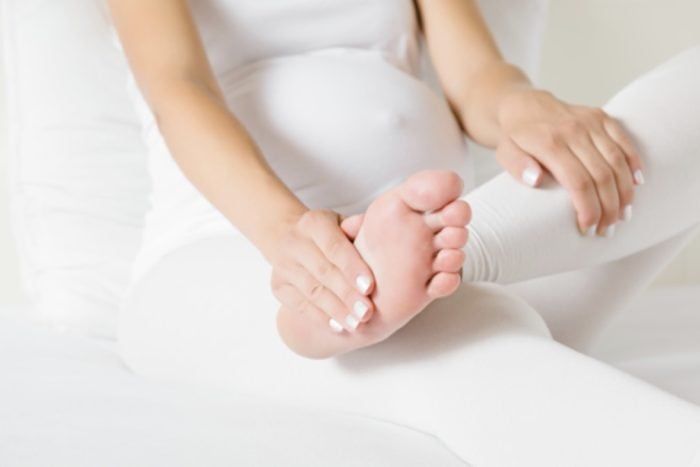
Swollen Feet and Ankles. Pregnancy is an incredible and transformative journey, but it often comes with its own set of unique challenges. As your body changes and adapts to nurture both you and your growing baby, one common issue that may arise is the discomfort of swollen feet and ankles.
You’re not alone in this experience, and there are reasons for these changes in your body. Let’s delve into what causes edema during pregnancy and explore ways to manage and find relief from this common discomfort.
Swollen Feet and Ankles – Learn About Pregnancy Edema
Swollen feet and ankles are a natural part of pregnancy for many women. The condition, known as edema, is a result of your body’s response to the increased demands of pregnancy. It can affect your entire body but often concentrates in the lower extremities due to the influence of gravity.
When Does Swelling Occur?
Edema is a companion for about three-quarters of expectant mothers, and it can make an entrance as early as the middle of the second trimester. If it does appear, it’s likely to stick around until your baby’s grand arrival.
However, it’s essential to note that around one in four pregnant women will not experience noticeable swelling. So, if you’re one of the lucky ones, rest assured that it’s perfectly normal.
Causes of Swollen Feet and Ankles
During pregnancy, your body undergoes GREAT changes to accommodate the needs of your developing baby. This includes an increase in body fluids, totalling around 6.5 litres or up to 15 pounds by term. These additional fluids are allocated to support the growth of your baby, the placenta, the amniotic fluid, and your maternal blood volume.
Edema is a direct result of this increased blood flow and the pressure exerted by your expanding uterus on the pelvic veins and vena cava, a major vein responsible for returning blood from your lower limbs to your heart.
The outcome? The all-too-familiar swelling, particularly in your feet and possibly your hands – as you may have noticed when attempting to remove a ring.
Another factor contributing to snug shoes during pregnancy is the hormone relaxin, which loosens ligaments throughout your body. This relaxation allows the bones in your feet to spread out and adapt to the changes.
And, as if to add a touch of humour to the situation, should you persist with your pre-pregnancy shoes, you may find your feet feeling a bit pinched. But don’t worry, after giving birth, the swelling will gradually recede, and your weight will return to a more familiar level.
However, it’s essential to be aware that the joints and ligaments in your feet may not revert entirely to their previous state, potentially leaving you with a more permanent, albeit minor, change – up to a full shoe size. So, shoe shopping might be on the postpartum to-do list.
Are There Any Risks Associated with Swollen Ankles and Feet?
While it might be far from enjoyable, mild swelling around ankles and feet caused by edema is, for the most part, harmless and considered perfectly normal during pregnancy. However, there are instances where you should seek prompt medical attention.
If you notice puffiness extending to your face, experience a rapid weight gain of more than five pounds in a single week, or if your swelling persists for over a day, particularly without improvement overnight, it’s time to reach out to your healthcare provider.
Excessive swelling can be an indicator of preeclampsia, a serious pregnancy-related condition. However, it’s important to note that in cases of preeclampsia, swelling is typically accompanied by other symptoms such as elevated blood pressure, protein in the urine, and potentially rapid weight gain.
If your blood pressure and urine, which are routinely checked during prenatal visits, appear normal, there’s generally no cause for concern. Edema alone is not typically a standalone symptom of preeclampsia, and your healthcare provider will be able to assess your overall condition during your check-ups.
In rare instances, leg swelling could signal a deep vein thrombosis (DVT), a condition where a blood clot forms in a deep vein. This condition tends to affect only one leg, often the left, and may lead to sensations of heaviness when standing, calf pain when flexing your foot, or skin that is red or warm to the touch.
Notably, in cases of DVT, the swelling in the affected leg is noticeably asymmetrical, with a calf circumference typically more than one centimetre greater than the unaffected leg.
If you observe any of these signs, don’t delay – contact your healthcare provider immediately. Diagnosis and evaluation can be easily accomplished through non-invasive ultrasound imaging of the veins in your legs.
Managing Swollen Feet and Ankles During Pregnancy
Now that you’re more informed about why swelling occurs during pregnancy and when it’s necessary to seek professional help let’s explore ways to manage and reduce this discomfort:
1. Take Breaks
If you find yourself standing for extended periods, be sure to take regular breaks and sit down. On the other hand, if you’re seated for prolonged periods, aim to take a brief five-minute stroll at least once an hour.
2. Elevate Your Legs
Whenever possible, raise your legs while you’re sitting. After all, who has a better excuse to put your feet up than a pregnant woman?
3. Sleep on Your Side
If you’re not already doing so, try to sleep on your side, preferably your left side. This position can help your kidneys function optimally, aiding in waste elimination and reducing swelling.
4. Stay Active
Incorporate pregnancy-appropriate exercises into your routine, such as walking. If your healthcare provider gives the green light, consider swimming. The water pressure in the pool can effectively push fluids stuck in your tissues back into your veins, allowing your body to eliminate excess fluids through urination.
5. Choose Comfortable Footwear
Comfort is key, particularly when you’re out and about. Consider orthotic shoes or inserts for additional support, which can not only make your feet feel better but also reduce leg and back pain during pregnancy. Once you return home, switch to a comfortable pair of soft slippers.
6. Compression Socks or Stockings
Opt for compression wear such as full pantyhose (with extra tummy room) or knee- or thigh-high options. Make sure they aren’t too tight at the top. To maximise their effectiveness, put them on in the morning before swelling typically sets in for the day.
7. Stay Hydrated
While it might seem counterintuitive, drinking at least 8-10 glasses of water daily will help your body eliminate excess sodium and other waste products, minimising swelling.
8. Moderate Your Salt Intake
Keep an eye on your salt consumption. Overindulging in salty foods can exacerbate swelling. Instead, salt your food to taste and maintain moderation.
Your pregnancy journey is a unique and remarkable experience, and it’s important to prioritise your well-being and comfort. While edema and swelling can be challenging, remember that they are typically a temporary part of the process.
By following these practical tips and seeking guidance from your healthcare provider, you can better manage and alleviate the discomfort, allowing you to focus on the joys and anticipation that come with welcoming a new life into the world.
This article is meant as general information, always consult your medical professional for advice. If in doubt, always consult your doctor.
For more articles like Swollen Feet and Ankles please see here



